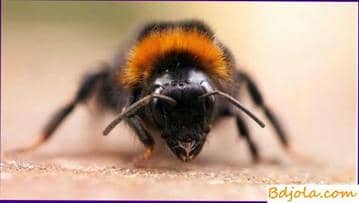
Septicemia – an infectious disease of bee colonies, which occurs under adverse conditions of detention, is accompanied by the death of adult bees.
Pathogen – Bacterium apisepticus – polymorphic, gram-negative, small, mobile, spore-forming rod 0.8-2.0X0.7-0.8 microns in size; facultative aerobic, temperature optimum of growth of 20-37 њ, grows well on ordinary nutrient media at pH 7.2-7.4; on the surface of the broth the film does not form; on agar gives large, well-delineated, with even edges, cloudy-opal in the center, bright to the periphery, oily, well-washed colonies. With continuous growth on agar, the culture has a dull greenish tinge.
In the broth, cloudiness forms to form a light precipitate. On the plate-shaped gelatin, colonies with a deep center of liquefaction are formed. When sown with a prick, the bacterium is funneled diluted gelatin during the injection and forms a bubble of gas at the top; on the agar Endo forms red colonies without changing the color of the medium.
Potatoes grow well-marked convex oily colonies, gradually darkening from brown to almost black, darkens and browns and the potatoes themselves. The bacterium coagulates and peptons the milk, forms acids, then alkalis (litmus on the second day becomes intensely pink, and by the sixth day it returns to the original blue color). Indole does not form, releases H2S, decomposes with the formation of gas (a small amount) and subsequent accumulation of alkali glucose, sucrose, maltose, mannitol, xylose.
The bacterium decomposes without gassing, but with the accumulation of alkali: fructose, galactose, mannose, salicin, sorbitol, glycerin; forms a small amount (trace) of acid in raffinose, arabinose, isodulcite, erythritol, starch and lactose; Do not decompose dextrin and pork fat (indicator – litmus); Nitrates are reduced to nitrites. Cultures of Bacterium apisepticum have a sharp putrefactive odor.
Highly virulent to bees are those stamps that in young cultures have mobility, do not split mannitol and lactose, do not form an indole, grow in the presence of KCN, break down glucose, adonite, give a positive reaction of the Foges-Proskauer, in most cases form H2S and slowly dilute gelatin.
The causative organism dies by heating to 73-74 њ for 30 minutes, with heating to 100 њ – for 3 minutes, sun rays and formalin vials are killed within seven hours. In the corpses of dead bees, which are under the influence of sunlight, the microbe dies within a month.
Pathogenicity is not the same and depends on the microbe stamp and method of infection. Feeding bacteria causes death of 10 to 90% of bees. Spraying bees by flushing culture causes death in the range 60-100%. When a healthy bee is planted to the sick, 15-20% of the latter die. White mice, pigeons and rabbits for subcutaneous administration of 1 ml of a daily culture washout do not respond.
Epizootic data.
The bacterium is widely distributed in nature, it is found in soil in the territory of the apiary, in water bodies and in healthy families and can penetrate into the body of bees in various ways.
The infection of bacteria in the hemolymph of the bee contributes to the disorder of the intestine, damage to the bee tissues by parasitic flies, beetle beetle larvae, ticks.
The course and symptoms of the disease. The disease manifests itself in separate families in the form of death of adult bees; flows in spring, summer, sometimes in autumn.
The forms of the disease can be pronounced, well expressed, under which there is a strong weakening of families, and hidden, when there is a slight death of bees.
The development of septicemia is promoted by high humidity: rainy summer, the penetration of precipitation into the nests of bees, the setting of an apiary in low, shaded and waterlogged places, liquid, unsealed food in the winter and a wet winter hut.
Sick bees are anxious, then they develop oppression, and they resemble frozen. The disease proceeds quickly; in patients with hemolymph bees white color, like milk. Death occurs a few hours after the appearance of the first signs of the disease. At dead bees the disintegration of tissues quickly develops. The chest muscles become dirty gray, then light brown and then almost black. At the same time, the connection between the chitinous segments is lost. With a light touch to the corpse, the latter breaks up into separate parts, which is a characteristic sign of this disease (the head, antennae, wings are separated, the abdomen splits into segments, and the legs and tendrils split into segments, the hairs separate from the chitin).
Diagnosis.
Preliminary diagnosis of septicemia is based on external signs. In patients, the hemolymph is taken from the abdomen, which becomes cloudy or milky in septicemia. The final diagnosis is based on the isolation from the hemolymph of sick bees of a pure culture of the causative agent of septicemia, B. api-septicum. Infect healthy bees when setting a biological sample by spraying with an aqueous suspension of the test bacterium.
Prevention.
Apiaries are located on dry soil, preferably on a small slope, away from large ponds and wetlands. The roofs of the hives should be serviceable, not skipping moisture. Families should be kept strong, in well-insulated nests; in winterers reduce the humidity by good ventilation.
Control measures.
When septicemia is detected, the bees are transplanted into a dry hive to keep them on compressed nests, remove honeycombs with liquid honey, and the hive is thoroughly insulated with dry insulating material. Zimovnik well ventilated, in the spring the bees are exposed to an elevated (not waterlogged) place.
Feed the bees with thick honey or 67% sugar syrup.
Пчеловодный ящик. Органы выделения пчел.
Diseases of bees